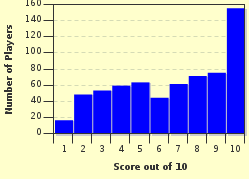Quiz Answer Key and Fun Facts
1. Karla is playing a set of variations in fa mineur. What key is fa mineur in English?
2. Cortney is practicing a nocturne in mi bémol majeur. How many flats can she expect to see in the key signature?
3. Craig is about to start working on a sonata in h-moll. To help him translate, what dictionary should he reach for?
4. Megan is studying orchestral excerpts from a symphony in B-dur. What key should she tell me the symphony is in when I quiz her about it?
5. Robert's repertoire for the recital includes a prelude and fugue in cis-moll. How many sharps belong in the key signature this poor lad is coping with?
6. Mike's busy preparing a concerto movement in la maggiore. If he wants to play studies in the same key as the concerto movement to help him get a better feel for the key, what studies should he select?
7. Stephanie seems to be having no trouble at all learning her mazurka in ut majeur. Why is this?
8. Earl is wondering about the cruel intentions of the composer who penned the "Tema con variazioni" in sol# minore. What key is Earl struggling with?
9. If Earl was having issues with his piece, Karen is suffering from serious sharp overload with her étude in ré dièse mineur. What key is her étude in?
10. Chris's Ges-dur Konzertstück is coming along quite nicely. How many flats are in the key of Ges-dur?
Source: Author
celicadriver
This quiz was reviewed by FunTrivia editor
agony before going online.
Any errors found in FunTrivia content are routinely corrected through our feedback system.

